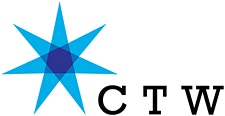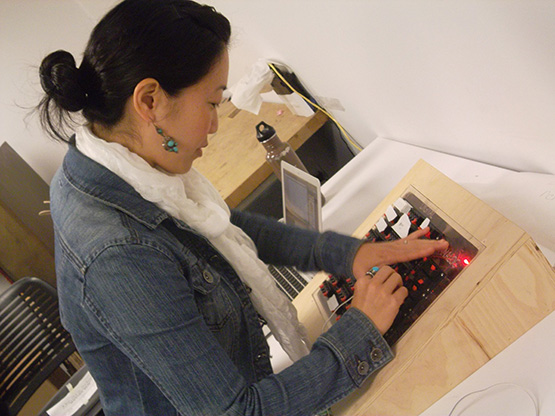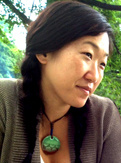A conversation about the promise, peril and responsibilities of NYC’s thriving creative technology scene, with one of NYC’s leading mentors of tomorrow’s artists, designers and programmers. By Don Undeen.
Don is the former Founding Manager of the Medialab at the Metropolitan Museum of Art in New York City.
Katherine Moriwaki is an Assistant Professor of Media Design in the School of Media Technology at Parsons School of Design. I first met her at the Parsons booth at Maker Faire 2013, and we later partnered in a Met/Parsons Collab Workshop on the topic of “Accessibility in Museums“. Katherine is also the Director of the MFA DT Program, a rotating title that gives her visibility into the amazing work by students and faculty throughout the entire program. I caught up with her in a Brooklyn coffee shop to get some insight into NYC’s amazing creative technology scene, exciting trends and people to keep an eye on in the coming year, and a sense of the opportunities and challenges facing the artists and technologists this decade.
DU: What do you love most about your job?
KM: Most of all I love the diversity creativity of the community, the students and the faculty at Parsons. Every day I see our students and faculty creating work that has relevance to the rest of the contemporary art/design/technology community. It’s exciting to be part of an enterprise that continues to produce graduates that go on to be leaders in their field, professionals doing valuable work.
DU: Tell me a bit about some of those students. What trends are big right now, and what are your students doing about it?
KM: There’s a lot of student interest in wearable technology and fashion right now. Recent graduates Jocelyn McDonald and Nicole Messier just kickstarted their thesis, a kit called “Blinkblink” that gets young girls excited about electronics through conductive fabrics and LEDs.
There’s a lot of work in Bio-Design that’s really interesting too. Jimmy Tang’s thesis “The Future of Food” explores alternative methods of agriculture, including the development of patches for literally growing food on your body.
We’ve also had some great projects in the area of data and surveillance. For his thesis, Gabriel Gianordoli’s analyzed and visualized the output of Google’s autocomplete algorithms, to provoke a reflection on our relationship with online sources of knowledge.
DU: You’re also a practicing creative technologist yourself. Tell me a bit about your own work, and what you’re up to these days.
KM: A lot of my work has to do with getting people to think about alternative interfaces of interactive experiences that don’t come in the traditional form of a sleek and easy-to-define consumer electronic device. I’m currently in the second year of a grant-funded project, GadgITERATION , funded by The Hive Digital Media Learning Fund in the NY Community Trust. GadgITERATION is a youth development program that looks at introducing basic electronics and interaction design to underserved youth.
DU: What do you think are the big issues Creative Technologists need to grapple with in the coming years?
KM: Creative technologists generally occupy a position of relative wealth and privilege, so there’s always a risk of having a blind spot where issues of diversity and equity are concerned. I’m proud that our students are generally well-educated on these complex, multi-dimensional social issues, and eager to tackle them head-on. This is not too surprising, given than Parsons exists within a school founded with a mandate for social change.
DU: What really excites you about the possibilities of Creative technology in NYC?
KM: The opportunity we have to change how people live their day-to-day lives in subtle yet significant ways. It’s up to us whether or not we build the tools and experiences that uplift people, engage them with their environment and each other, and raise awareness of our shared responsibility in society. I think it’s possible, and I’ve seen a lot of great work from my students that hints at that. That’s what we as artists and creative professionals should strive for.
DU: What do you think makes NYC so great for Creative Technology?
KM: NYC tech professionals understand cities, density, and diversity, and this helps to connect us to other parts of the world that share the same characteristics. There are specific challenges of living in cities that are relatable across many dense urban environments, and NYC technologists are well positioned to address these challenges, in a way that other creative technology centers in the US can’t match.
DU: Thanks so much Katherine. We’re really looking forward to seeing the contribution you and the rest of the Parsons crew will be making to Creative Tech Week 2016!
[Bonus Track: During this interview, a giant “cicada killer” wasp landed on the interviewer’s shirt, and proceeded to crawl up his neck and onto his face. While Katherine handled the situation with grace and aplomb, the interviewer’s reaction was less zen. This portion of the interview recording has been shared on soundcloud for your amusement. Warning, contains some mild NSFW language.]
In 2012 Don Undeen was tasked with establishing a space for experimentation at the intersection of art, technology, and the museum experience. By working closely with NYC’s creative technology community, the MediaLab developed a worldwide reputation for consistently delivering provocative, exciting, and valuable projects. Currently an independent consultant, Don continues to bring together cultural experts and technologists to explore new connections between collections and electrons.


